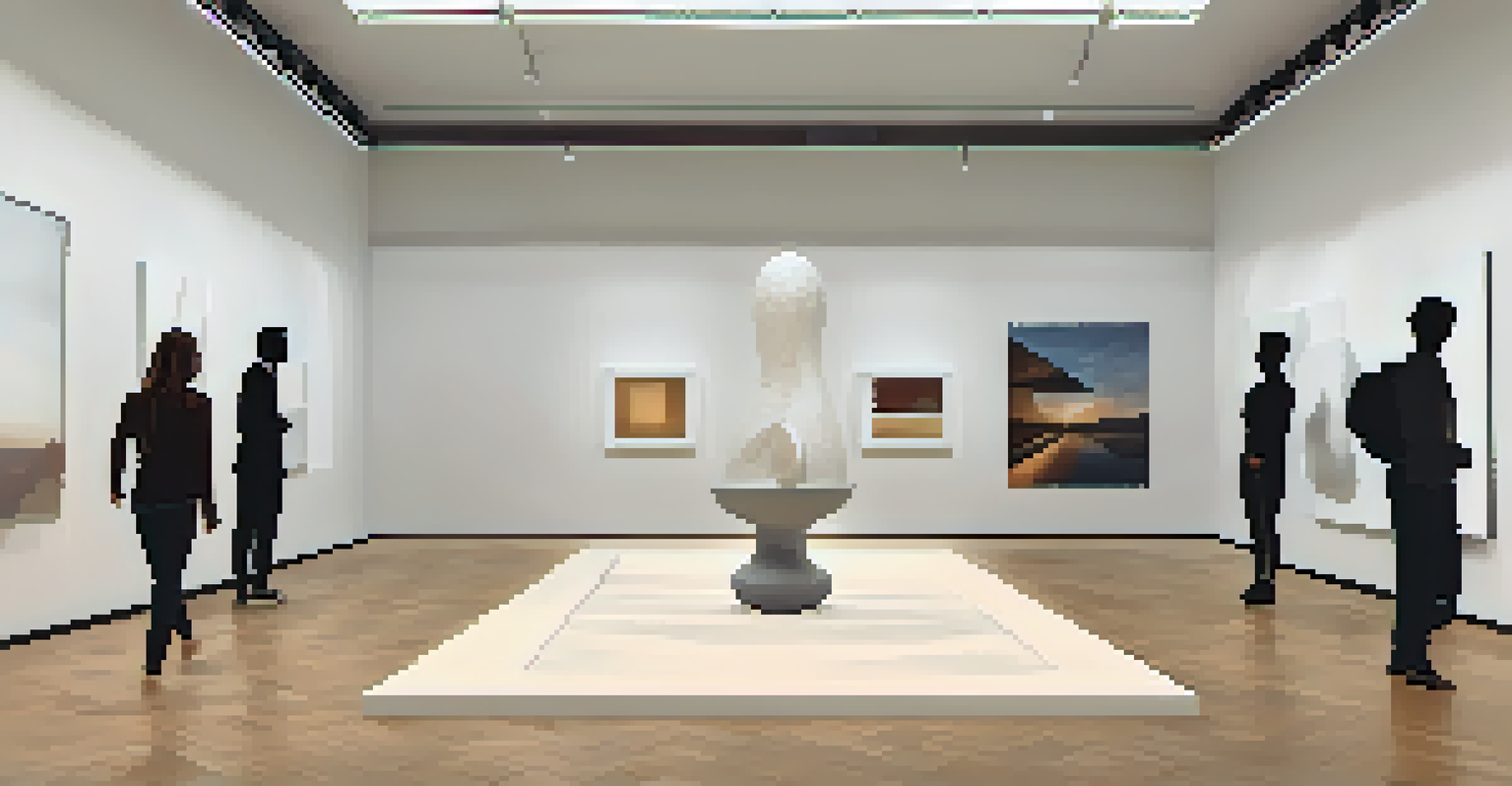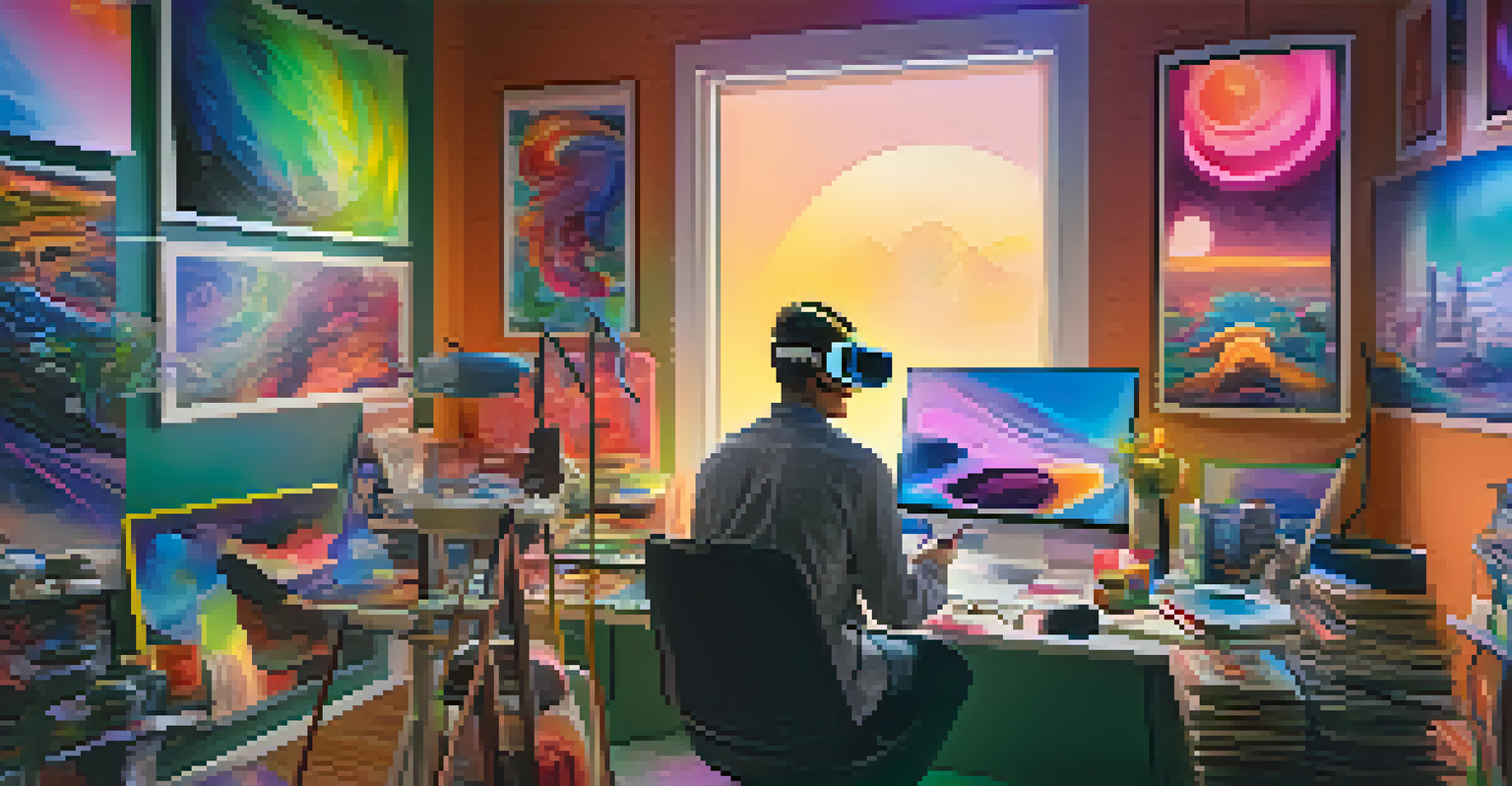How Artists Use Virtual Reality to Redefine Visual Experiences

Introduction to Virtual Reality in Art
Virtual reality (VR) is revolutionizing the art world by offering immersive experiences that were previously unimaginable. Artists can create entire worlds that viewers can step into, rather than just observing art from a distance. This shift challenges traditional notions of art consumption, making it more interactive and engaging for audiences.
Art is not what you see, but what you make others see.
Imagine walking through a gallery where you can not only see but feel the artwork surrounding you. VR allows for a multi-sensory experience, enhancing emotional connections and engagement. As technology evolves, the boundaries of what constitutes art continue to expand, inviting new interpretations and experiences.
The intersection of technology and creativity in VR opens up endless possibilities for artists. They can experiment with scale, depth, and perspective in ways that traditional mediums simply cannot accommodate, pushing the limits of their craft.
Creating Immersive Experiences with VR
One of the most exciting aspects of VR is its ability to create fully immersive environments. Artists can design spaces that transport viewers to different worlds, evoking emotions and narratives in a dynamic way. For example, an artist might create a serene forest where viewers can interact with digital flora and fauna, experiencing nature in a new light.

These immersive experiences challenge the passive consumption of art. Instead, viewers become active participants, influencing their surroundings and engaging with the art on a personal level. This interaction can lead to a deeper understanding of the artist's message and intentions.
VR Transforms Art Engagement
Virtual reality allows viewers to actively engage with art, creating immersive experiences that deepen emotional connections.
Moreover, VR can enhance accessibility, allowing individuals who may not typically visit galleries or museums to engage with art. By breaking down physical barriers, artists can reach a broader audience and share their vision with the world.
The Role of Technology in Artistic Creation
The tools available for creating VR art are continually advancing, offering artists innovative ways to express their ideas. Software like Tilt Brush allows creators to paint in a 3D space, enabling them to think beyond traditional canvases. This technology empowers artists to explore new dimensions and experiment with form and structure.
The future belongs to those who believe in the beauty of their dreams.
Additionally, the integration of augmented reality (AR) into VR art has added another layer of complexity and interactivity. Artists can layer digital elements onto physical spaces, creating a hybrid experience that captivates viewers in unique ways. This fusion of technologies blurs the line between the real and the imagined.
As artists embrace these technological advancements, they contribute to a new language of art that resonates with contemporary audiences. The result is a more vibrant, diverse artistic landscape that reflects the ever-evolving relationship between creativity and technology.
Impact on Audience Engagement and Interaction
With VR, audience engagement takes on a whole new meaning. Instead of simply looking at a piece of art, viewers can interact with it, exploring its intricacies and layers. This participatory approach fosters a sense of connection between the artwork and the observer, enhancing the overall experience.
Imagine stepping into a virtual sculpture that you can walk around and examine from all angles. This level of engagement allows for personalized interpretations, making art feel more relevant and immediate. It’s a shift from passive observation to active exploration, inviting viewers to become co-creators in the experience.
New Storytelling Opportunities
Through VR, artists can craft interactive narratives that invite audiences to explore themes of identity and social issues.
Such interactions can also lead to deeper conversations about the themes and messages within the art. As viewers engage more fully, they may discuss their interpretations, creating a communal experience that enriches the understanding of the artwork.
Exploring New Narratives through VR Art
VR provides an incredible platform for storytelling, allowing artists to weave narratives that are both visual and experiential. Through immersive environments, artists can guide viewers through a storyline, inviting them to uncover layers of meaning as they navigate the virtual space. This storytelling element enhances emotional engagement, making the experience unforgettable.
For instance, an artist might create a VR installation that explores themes of identity and belonging, leading viewers through a series of scenes that reflect different aspects of the human experience. This narrative-driven approach can evoke empathy and provoke thought, encouraging audiences to reflect on their own lives.
Moreover, the ability to shift perspectives in VR art offers new insights into familiar narratives. By placing viewers in different roles or viewpoints, artists can challenge assumptions and prompt critical thinking about social issues or personal experiences.
Challenges and Limitations of VR in Art
Despite its many advantages, the use of VR in art also comes with challenges. The technology can be expensive and requires a certain level of technical know-how, which may deter some artists from exploring this medium. Additionally, the rapid evolution of technology means that artists must constantly adapt to new tools and platforms.
There are also concerns about accessibility, as not everyone has access to the necessary hardware or internet connection to experience VR art. This can inadvertently create a divide, limiting the audiences that can engage with this innovative form of expression.
Challenges of VR in Art
Despite its potential, VR in art faces challenges such as high costs, accessibility issues, and the risk of overshadowing artistic intent.
Furthermore, some critics argue that the novelty of VR may overshadow the artwork itself, leading to experiences that prioritize technology over artistic intent. It's essential for artists to strike a balance between leveraging technology and maintaining the emotional and conceptual core of their work.
The Future of VR in the Art World
As technology continues to advance, the future of VR in art looks incredibly promising. Artists are increasingly embracing this medium, leading to a surge of creativity and innovation that could redefine how we experience art. With each new development, the potential for immersive storytelling and interactive engagement expands.
We may see more collaborations between artists and technologists, resulting in groundbreaking projects that push the boundaries of imagination. Exhibitions may evolve into multi-sensory experiences where viewers can engage with art in ways we have yet to fully explore.

Ultimately, the integration of VR in the art world will likely continue to evolve, influencing not only how artists create but also how audiences experience and connect with art. This transformative journey is just beginning, and it promises to reshape our understanding of visual experiences in profound ways.